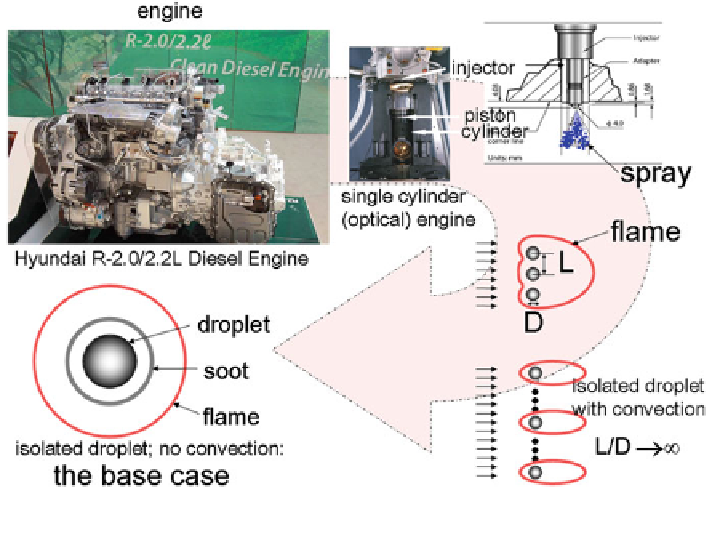Environmental Engineering Reference
In-Depth Information
Fig. 3 Context of the spherically symmetric droplet burning configuration to the stochastic
environment of an engine
A hierarchy for combustion of a liquid fuel is envisioned as depicted in Fig.
3
that includes a full spray, 3-D multi-droplet cloud, and 2-D array with inter-droplet
spacing
gurations is yet amenable to ab initio
modeling that includes simultaneously the effects of time-dependent gas and liquid
transport, moving boundary of the liquid/gas interface as evaporation occurs, var-
iable properties, detailed combustion chemistry, and radiation. Even if L is arbi-
trarily
“
L
”
. For
finite L, none of these con
such that a single isolated drop is realized but convective effects are
still present, detailed numerical simulation has not yet been accomplished, though
approaches have included some (but not all) of these elements (Sirignano
1999
).
Currently, it appears that only for the single stationary isolated droplet (L
“
large
”
→
∞
in Fig.
3
), burning in a quiescent ambience with no convective effects (forced or
buoyancy-induced) can detail numerical simulation based on a
first-principles
solution be carried out that incorporates all the physical processes mentioned above,
except for soot formation (Farouk et al.
2013
, Liu et al.
2013a
; Cuoci et al.
2005
).
Figure
4
a is a schematic of this con
guration.
The gas
fl
flow will be one-dimensional and only in the radial direction, and the
fl
flow is created entirely by the evaporation process. If soot forms [Fig.
4
b, c (Liu
et al.
2014a
)], the soot aggregates will be trapped between the droplet and
fl
ame by
the forces acting on the particles (Avedisian
1997
). The con
guration of
“
”
Fig.
4
represents the
base case
of liquid fuel combustion as a building block for
complex droplet con
gurations that lead to spray dynamics.

Search WWH ::

Custom Search